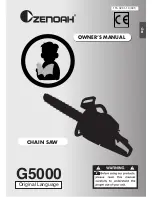
GB
62
– Wipe down the device with a slightly
damp cloth.
Cleaning the oil guide groove of the saw
rail
– Remove the saw rail.
– Clean dirt from the oil guide groove of the
saw rail with a suitable tool. (plastic spat-
ula, do not use any steel tools!)
Re-tensioning the saw chain
– Lift the tip of the saw rail slightly.
– Tighten the tensioning screw (6) until the
chain lies on the underside of the saw rail.
Sharpening the saw chain
Special tools are required to sharpen the saw
chain; these guarantee that the cutting of the
chain occurs at the correct angle and the cor-
rect depth. We recommend that you have the
saw chain sharpened by a professional.
Storage and transport
Storage
•
Let the device cool down before you store
it.
•
Store the device as horizontally as possi-
ble.
Longer downtimes
If you are not going to be using the device for
a while, remove the chain oil from the device.
Store the device in a dry place.
Transport
If you are transporting the device in a vehicle:
– Slip the protective cover onto the cutting
tool.
– Secure the device against slipping.
– If possible, use the original packaging for
dispatching.
Faults and remedial measures
When something isn’t working…
Malfunctions are often caused by minor
faults. You can easily remedy most of these
yourself. Please consult the following table
before contacting the vendor. You will save
yourself a lot of trouble and possibly money
too.
If you can’t fix the fault yourself, contact your
nearest vendor. Please be aware that any
improper repairs will also invalidate the war-
ranty and additional costs may be incurred.
Disposal
Disposal of the appliance
A crossed-out wheelie bin icon
means: Batteries and rechargeable
batteries, electrical or electronic
devices must not be disposed of with
household waste. They may contain
substances that are harmful to the environ-
ment and human health.
Consumers must dispose of waste electrical
devices, spent portable batteries and
rechargeable batteries separately from
household waste at an official collection point
to ensure that these items are processed cor-
rectly. Information on returning these items is
available from the seller. Sellers are required
to accept these items free of charge.
Batteries and rechargeable batteries,
which are not permanently installed in
waste electrical devices, must be
removed prior to disposal and must be
disposed of separately. Lithium batteries and
battery packs in all systems must only be
retuned to a collection point when dis-
DANGER! Risk of injury!
Make
sure that unauthorized persons do
not have access to the device!
DANGER! Risk of injury!
Improp-
erly performed repairs can lead to the
device not functioning safely. This
endangers yourself and your environ-
ment.
Fault/malfunction
Cause
Remedial measure
Device does not work.
Battery not slotted in correctly?
Slot battery into place.
Battery pack discharged?
Battery pack defective?
Contact your local vendor.
Is the device defective?
LI-ION
Summary of Contents for A-KS-2x20/4/30
Page 3: ...3 1 2 3 4 5 7 6 8 9 10 1 14 20 11 12 13 2 15 16 17 18 19 3 ...
Page 4: ...4 8 7 4 5 7 6 6 2 8 MAX MIN 7 17 8 18 9 ...
Page 5: ...5 3 11 12 10 ...
Page 236: ...236 RU ϗϴЄϴЁІϼϽЁЏϽ ІϴϿЂЁ ё ϗϴЄϴЁІϼϽЁЏϹ ЇЅϿЂ ϼГ 1 2 24 3 ...
Page 237: ...237 4 20 13109 97 ...
Page 242: ...242 ...
Page 243: ...243 ...
















































